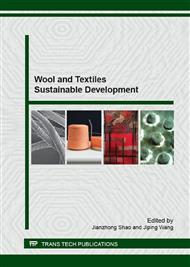[1]
B.O. Brooks, W.F. Davis, Understanding Indoor Air Quality, CRC, Boca Raton, USA, (1992).
Google Scholar
[2]
P.E. Ingham, S.M. Causer, R.C. McMillan, The role of wool carpets in controlling indoor air pollution, Proc. Text. Inst. Conf. Blackpool, UK, (1994).
Google Scholar
[3]
S. McNeil, Removal of Indoor Air Contaminants by Wool Carpet, AgResearch Technical Bulletin, AgResearch, Christchurch, New Zealand, (2014).
Google Scholar
[4]
M. Walsh, A. Black, A. Morgan, G.H. Crawshaw, Sorption of SO2 by typical indoor surfaces, Atmos. Environ. 11 (1977) 1107-1111.
DOI: 10.1016/0004-6981(77)90242-6
Google Scholar
[5]
P. Ingham, Fire Safety of Wool Carpets, WRONZ Technical Bulletin, Wool Research Organisation of New Zealand, Christchurch, New Zealand, (1999).
Google Scholar
[6]
S. McNeil, Acoustic Advantages of Wool Carpeting, AgResearch Technical Bulletin, AgResearch, Christchurch, New Zealand, (2014).
Google Scholar
[7]
P. Martini, M.J. Spearpoint, P.E. Ingham, Low-cost wool-based fire blocking inter-liners for upholstered furniture, Fire Safety J. 45 (2010) 238-248.
DOI: 10.1016/j.firesaf.2010.03.005
Google Scholar
[8]
R.A. McCall, S.J. McNeil, Comparison of the energy, time and water usage required for maintaining carpets and hard floors, Indoor Built Environ. 16 (2007) 482-486.
DOI: 10.1177/1420326x07082781
Google Scholar
[9]
W. Meade, Consumer Properties of Carpets, WRONZ Technical Bulletin, Wool Research Organisation of New Zealand, Christchurch, New Zealand, (1998).
Google Scholar
[10]
S.J. McNeil, M.R. Sunderland, L.I. Zaitseva, Closed-loop wool carpet recycling, Resour. Conserv. Recy. 51 (2007) 220-224.
DOI: 10.1016/j.resconrec.2006.09.006
Google Scholar
[11]
W.H. Rees, Heat insulation properties of carpets, Carpet Rev. 23 (1969) 39-51.
Google Scholar
[12]
P.E. Ingham, M.R. Sunderland, S.J. McNeil, R. Marazzi, Lanasan NCF: Nanoparticles enhance carpet performance, Int. Dyer, 191 (2006) 23-25.
Google Scholar
[13]
S.J. McNeil, L.S. Tapp, The design and initial evaluation of visual cues in carpets to assist walking, J. Text. Inst. ahead-of-print (2015).
Google Scholar
[14]
K. Corscadden, J. Biggs, D. Stiles, Sheep's wool insulation, Res. Cons. Recy. 86 (2014) 9-15.
Google Scholar
[15]
N.A.G. Johnson, E.J. Wood, P.E. Ingham, S.J. McNeil, I.D. McFarlane, Wool as a technical fibre, J. Text. Inst, 94 (2003) 26-41.
Google Scholar
[16]
U.R. Amrit, Bedding textiles and their influence on sleep. AUTEX Res. J. 8 (2007) 252-254.
Google Scholar
[17]
C. Garrow, L.J. Stephens, M.R. Ewing, Evaluation of surgical masks: The potential of resin-treated wool, Surgery, 69 (1971) 881-883.
Google Scholar
[18]
S.J. McNeil, Heavy metal removal using wool filters, Asian Text. J. 10 (2001) 88-90.
Google Scholar
[19]
J.A. Schutz, W. Humphries, A Study of wool/polypropylene nonwovens as an alternative to the Hansen filter, Text. Res. J. 80 (2010) 1265-1277.
Google Scholar
[20]
S.J. Leighs, S.J. McNeil, W.J. Meade, Wool filtration media opportunities and applications. Visions for Fibres and Textiles Conference, Melbourne, Australia, (2012).
Google Scholar
[21]
T. Kinney, Wool: Master's Design Thesis, University of Texas, Austin, USA, (2014).
Google Scholar
[22]
R.H.T. Barker, M.E. Taylor, P. Johnstone, C. van Koten Biodegradation of Wool Carpet Pile, AgResearch Technical Bulletin, AgResearch, Christchurch, New Zealand, (2013).
Google Scholar
[23]
P. Gibbs, The land recycling option for wool carpet. Carpet Recycling UK Conference, 2009, UK.
Google Scholar
[24]
V.V. Kadam, L.R. Meena, S. Singh, D.B. Shakyawar, S.M.K. Naqvi, Utilization of coarse wool in agriculture for soil moisture conservation. Indian J. Small Ruminants, 20 (2014) 83-86.
Google Scholar
[25]
R.S. Górecki, M.T. Górecki, Utilization of waste wool as substrate amendment in pot cultivation of tomato, sweet pepper, and eggplant. Pol. J. Environ. Stud. 19 (2010) 1083=1087.
Google Scholar
[26]
V.D. Zheljazkov, Wool-waste as organic nutrient source. Waste Management, 29 (2009) 2160-2164.
DOI: 10.1016/j.wasman.2009.03.009
Google Scholar
[27]
Information on www. campaignforwool. org/2014/10/14/biodegradable-wool-test-complete.
Google Scholar


